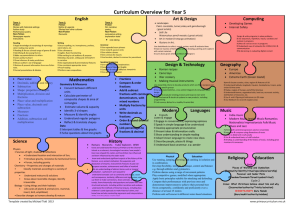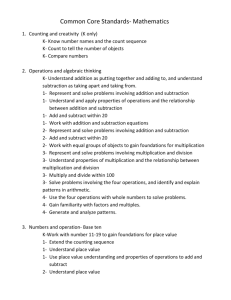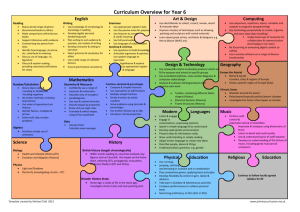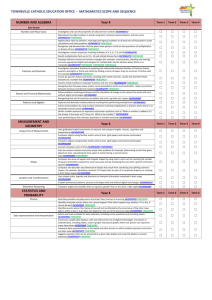KENDRIYA VIDYALAYA SANGATHAN ZONAL INSTITUTE OF
advertisement
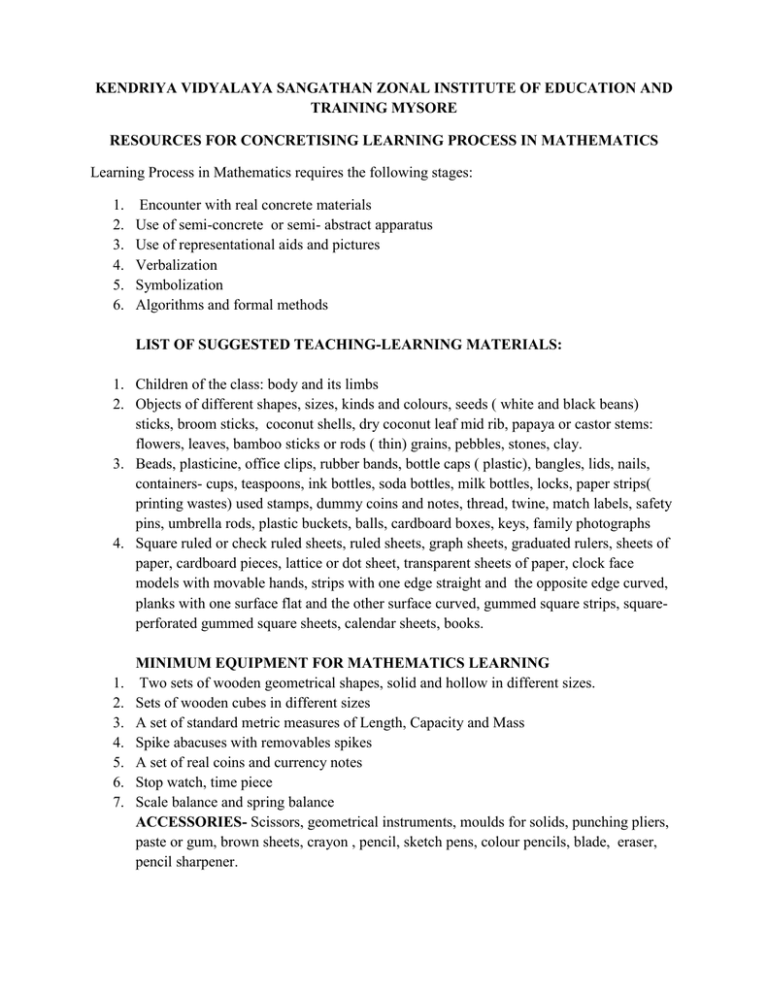
KENDRIYA VIDYALAYA SANGATHAN ZONAL INSTITUTE OF EDUCATION AND TRAINING MYSORE RESOURCES FOR CONCRETISING LEARNING PROCESS IN MATHEMATICS Learning Process in Mathematics requires the following stages: 1. 2. 3. 4. 5. 6. Encounter with real concrete materials Use of semi-concrete or semi- abstract apparatus Use of representational aids and pictures Verbalization Symbolization Algorithms and formal methods LIST OF SUGGESTED TEACHING-LEARNING MATERIALS: 1. Children of the class: body and its limbs 2. Objects of different shapes, sizes, kinds and colours, seeds ( white and black beans) sticks, broom sticks, coconut shells, dry coconut leaf mid rib, papaya or castor stems: flowers, leaves, bamboo sticks or rods ( thin) grains, pebbles, stones, clay. 3. Beads, plasticine, office clips, rubber bands, bottle caps ( plastic), bangles, lids, nails, containers- cups, teaspoons, ink bottles, soda bottles, milk bottles, locks, paper strips( printing wastes) used stamps, dummy coins and notes, thread, twine, match labels, safety pins, umbrella rods, plastic buckets, balls, cardboard boxes, keys, family photographs 4. Square ruled or check ruled sheets, ruled sheets, graph sheets, graduated rulers, sheets of paper, cardboard pieces, lattice or dot sheet, transparent sheets of paper, clock face models with movable hands, strips with one edge straight and the opposite edge curved, planks with one surface flat and the other surface curved, gummed square strips, squareperforated gummed square sheets, calendar sheets, books. 1. 2. 3. 4. 5. 6. 7. MINIMUM EQUIPMENT FOR MATHEMATICS LEARNING Two sets of wooden geometrical shapes, solid and hollow in different sizes. Sets of wooden cubes in different sizes A set of standard metric measures of Length, Capacity and Mass Spike abacuses with removables spikes A set of real coins and currency notes Stop watch, time piece Scale balance and spring balance ACCESSORIES- Scissors, geometrical instruments, moulds for solids, punching pliers, paste or gum, brown sheets, crayon , pencil, sketch pens, colour pencils, blade, eraser, pencil sharpener. CONCEPTS I FROM NUMBER SENSE TO NUMBER CONCEPTS- NATURAL NUMBERS AND WHOLE NUMBERS 1. Forming Sets 2. Pre-number concepts 3. Numbers one to five 4. One more or one less 5. Numbers six to nine and counting 6. Numerals 7. Zero 8. Counting forwards from a stage 9. Higher unit of ten and counting tens 10. Two digit number and counting from one to hundred 11. Hundred 12. Numbers having three digit numerals 13. English names of higher units ( optional) 14. Place Value system in base ten II OPERATIONS WITH WHOLE NUMBERS 1. Meaning of addition 2. Basic addition facts, properties and tables 3. Complementary addition facts 4. Addition Algorithm or process 5. Comparison of numbers 6. Meaning of subtraction 7. Subtraction algorithm or process 8. Relations between addition and subtraction 9. Skip Counting and repeated addition 10. Meaning of multiplication 11. Basic multiplication facts, properties and tables 12. Multiplication algorithm or process 13. Meaning of division 14. Division algorithm or process 15. Relations between multiplication and division III KINDS OF NUMBERS AND THEIR PROPERTIES- SUBSETS OF THE NATURAL NUMBER SYSTEMS 1. 2. 3. 4. 5. 6. 7. Cardinal and Ordinal numbers Odd and even numbers Factor and multiple Prime and composite CM and L.C.M C.F. and H.C.F Relatively prime or co prime IV. BASIS OF DIVISIBILITY RULES 1. Numbers as sums 2. Numbers as products 3. Numbers as sums of products 4. Divisors of dividends and their sums 5. Divisor of a number and the multiple of the number 6. Divisibility of higher units by five and ten 7. Divisibility of higher units by three and nine 8. Divisibility of higher units by two, four and eight V. FROM WHOLE TO PART AND PART TO WHOLE 1. Whole and part 2. Naming parts 3. Equivalent fractions 4. Comparison of ‘ simple fractions’ 5. The relation between whole numbers and ‘ simple fractions’ 6. Addition and subtraction of ‘simple fractions’ – meaning and method 7. Multiplication of ‘ simple fractions’- meaning and method 8. ‘simple fractions’ and their reciprocals 9. Division with ‘simple fractions’ 10. ‘simple fractions’ in decimal notation 11. Addition and subtraction of ‘decimal fractions’ 12. Multiplication of ‘decimal fractions’- meaning and method 13. Division with ‘decimal fractions’- meaning and method 14. ‘fractions’ and ‘percentages’ VI CONCEPTS THROUGH PRACTICAL WORK FOR APPLICABILITY 1. Ratio and fractions 2. Direct variation 3. Inverse variation 4. Averages 5. Data in pictures VII SHAPES AND NUMBER 1. Classifying and naming solid shapes 2. Testing straightness and flatness 3. Looking at solid shapes 4. Making hollow solid shapes 5. Plane shapes- rectilinear 6. Plane shapes- circular 7. Angles and their kinds and measures 8. Angles in plane shapes and angle sums of plane shapes 9. Symmetry in plane shapes VIII FROM MEASUREMENT TO MENSURATION 1. Length and its measure 2. Perimeter and its measure 3. Time and its measure 4. Money and its measure 5. Capacity and its measure 6. Mass ( or weight) and its measure 7. Area and its measure 8. Formulae for areas of shapes 9. Volume and its measure 10. Formulae for volumes of solid shapes
